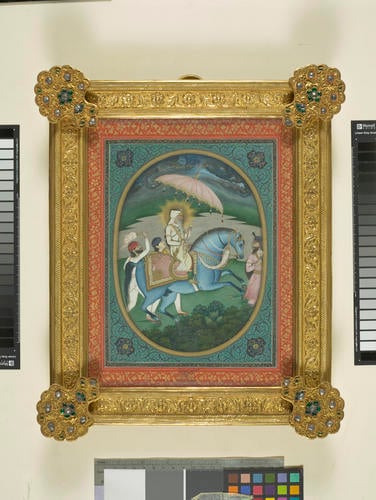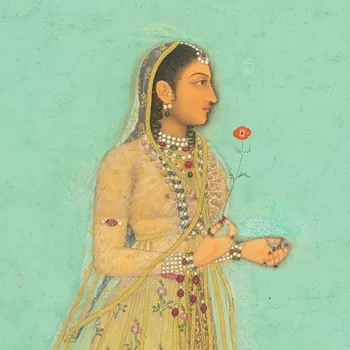Maharajah Ranjit Singh c. 1840
opaque watercolour including metallic paints on paper | 26.9 x 20.4 cm (sight) | RCIN 452414
-
A posthumous portrait of Maharajah Ranjit Singh (1780-1839), the founder of the Sikh Kingdom of the Punjab.
In May 1843 Queen Victoria received a delivery of presents from Sher Singh, Maharajah of the Punjab (r. 1841-3). Among them was this portrait of his late father, Maharajah Ranjit Singh (r. 1801-39), in a jewel encrusted gold frame. This was the first Indian painting acquired by the young queen. Painted by the Lahori artist Imam Bakhsh, the portrait depicts Maharajah Ranjit Singh riding his favourite horse, Layli.
A note on the back of the painting reads ‘See Miss Eden’s letters from India’. Emily Eden (1797-1869) was the sister of Lord Auckland (East India Company Governor-General, 1836-42), and a correspondent of Queen Victoria. She travelled to Lahore in her brother’s suite in the late 1830s and painted Maharajah Ranjit Singh seated on a chair (see RCIN 1070252 pl. XIII). Baron von Hugel, an Austrian visitor to the court of Lahore, recorded the significance of Ranjit Singh being painted on horseback as opposed to Emily Eden’s depiction: ‘When he [the Maharajah] seats himself in a common English armchair, with his feet drawn under him, the position is one particularly unfavourable to him; but as soon as he mounts his horse, and with his black shield at his back, puts him on his mettle, his whole form seems animated by the spirit within, and assumes a certain grace, of which nobody could believe it susceptible. In spite of the paralysis affecting one side, he managed his horse with the greatest ease’ (Hugel, Travels In Kashmir And Punjab, 1845, pp.380-1).
The painter Imam Bakhsh (active c.1825–45) was employed by many members of Lahore’s nobility although he is best known for his paintings commissioned by Claude Auguste Court and Jean Baptiste Ventura, French and Italian generals in Ranjit Singh’s army. In 1838, General Ventura had French artist Alfred de Dreux paint a large oil painting based on a similar equestrian portrait of the Maharajah by Imam Bakhsh to present to King Louis-Philippe of France (Musée du Louvre Inv. 4096). An engraving of this appeared in the London Illustrated News (see RCIN 618762). In 1841 Imam Bakhsh painted another comparable equestrian portrait of Maharajah Ranjit Singh for General Court (Musee Guimet BG 399756).
The jewel-encrusted gold frame of Imam Bakhsh's painting in the Royal Collection is of a type used for earlier diplomatic portraits presented to and from Ranjit Singh and the East India Company. In 1831, Lord Betnick (Governor-General from 1828 to 1835) sent his portrait to the Maharajah in a frame ‘well-set with gold and jewellery’ (Suri, Umdat ul-Tawarikh, vol III, p. 94). Ranjit Singh later presented Lord Auckland with his portrait ‘sumptuously framed with diamonds within two rows of pearls’ (Cunningham, A History of the Sikhs, 1849, p.223). In 1838, Lord Auckland presented a portrait of Queen Victoria in her coronation robes, painted by Emily Eden, to Ranjit Singh for which the East India Company provided a frame. Emily Eden’s description of this frame is identical to that which surrounds Imam Baskhsh’s portrait of Ranjit Singh: ‘It is solid gold, very well worked, with a sort of shell at each corner, encrusted with precious stones, and one very fine diamond in each shell. The materials came to about £500. Forty jewellers of Delhi worked at it night and day, and the head jeweller expects a expects a khelwut, or robe of honour, with a pair of shawls, for his activity.’ (Eden, Up The Country, 1866, p.193). Queen Victoria wrote in her diaries that she received ‘an amusing letter from Emily Eden, giving a most amusing account of Runjeet Singh, and the honour he paid a Picture, which she painted of me, and which was set in jewels and given to him’ (RA VIC/MAIN/QVJ: 14 February 1839).
Sher Singh presented Imam Bakhsh’s portrait of Maharajah Ranjit Singh with several other gifts intended for Queen Victoria through his son Prince Pratap Singh to Lord Ellenborough (Governor-General 1842-4) at his camp at Firozpur in January 1843. Accompanying these ‘tokens of friendship’ was a letter to the Queen sending belated congratulations on her marriage and the birth of her first son. Leopold von Olrich, a young German soldier, described the presentation of the gifts: 'A present intended for the Queen of England was next exhibited. It was a perfectly beautiful green Kashmir tent, embroidered with silk, containing a silver bed and morning dress for ladies, with pearls, jewels and other ornaments while the floor was covered with the finest Kashmir shawls. But the Prince seemed to think a great deal more of a wretched portrait of Runjeet Singh, daubed on paper with water-colours, which was to accompany the present' (Orlich, Travels in India, 1845, p. 204). Pratap Singh’s esteem for the portrait tells of the veneration in which the late Maharajah was still held.
Queen Victoria received the gifts at Buckingham Palace on Monday 1st May 1843 and recorded in her journal ‘I saw some of the many most magnificent presents, sent me by the Maharajah of Lahore, — jewels, shawls &c, of the most exquisite beauty’ (RA VIC/MAIN/QVJ: 1 May 1843). In return Queen Victoria sent gifts including silver plate to Maharajah Sher Singh which reached Bombay on 9th September 1843 to be forwarded to Firozpur. A week later intelligence reached Bombay of the Maharajah’s assassination and the Governor General ordered the box to be returned unopened to England (BL IOR/F/4/2050/93545).Provenance
Given by Maharajah Sher Singh (son and successor of Ranjit Singh) to Lord Ellenborough for presentation to Queen Victoria, January 1843.
-
Creator(s)
(artist)Acquirer(s)
-
Medium and techniques
opaque watercolour including metallic paints on paper
Measurements
26.9 x 20.4 cm (sight)
37.0 x 29.9 cm (frame, external)
Place of Production
Lahore [Punjab]












